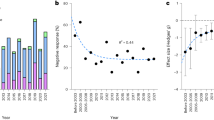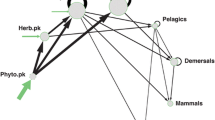Abstract
The Lotka–Volterra predator-prey-model is a widely known example of model-based science. Here we reexamine Vito Volterra’s and Umberto D’Ancona’s original publications on the model, and in particular their methodological reflections. On this basis we develop several ideas pertaining to the philosophical debate on the scientific practice of modeling. First, we show that Volterra and D’Ancona chose modeling because the problem in hand could not be approached by more direct methods such as causal inference. This suggests a philosophically insightful motivation for choosing the strategy of modeling. Second, we show that the development of the model follows a trajectory from a “how possibly” to a “how actually” model. We discuss how and to what extent Volterra and D’Ancona were able to advance their model along that trajectory. It turns out they were unable to establish that their model was fully applicable to any system. Third, we consider another instance of model-based science: Darwin’s model of the origin and distribution of coral atolls in the Pacific Ocean. Darwin argued more successfully that his model faithfully represents the causal structure of the target system, and hence that it is a “how actually” model.

Similar content being viewed by others
Notes
Is it epistemologically significant whether our methodological studies proceed top-down or bottom-up? Perhaps not in principle, and certainly not if it turns out that all cases can be accommodated to a unitary account of confirmation. We would welcome such a result. However, if the foxes prove to be right, then a top-down approach may impede progress by obscuring natural categories.
“Mais dans le domaine de l’oecologie ces méthodes [the experimental methods] n’ont été jusqu’à présent que fort peu appliquées et cela s’explique, si l’on songe que les phénomènes biologiques ne sauraient devenir l’objet d’une étude quantitative qu’après avoir été isolés des causes extrinsèques susceptibles d’agir sur leur cours et d’en troubler les résultats” (Volterra and D’Ancona 1935, p. 6).
We are not denying the possibility of experimental ecology, which today is a rich discipline. We do, however, believe that Volterra and D’Ancona are pointing out real difficulties.
The argument only says that it is too difficult to establish population dynamics in the wild by statistical methods. It does not speak against the use of descriptive statistics, such as the fishery statistics with which D’Ancona tests the applicability of the predator-prey-model.
“[L]’étude quantitative, par voie d’observation et d’expérience, des associations biologiques est chose ardue” (Volterra and D’Ancona 1935, p. 8).
“D’ailleurs s’il apparait trop difficile d’effectuer l’étude quantitative par voie d’expérience et d’obtenir ainsi les lois qui règlent les rapports interspécifiques dans les associations biologiques, on pourra tenter de découvrir ces mêmes lois par voie déductive et de voir ensuite si elles comportent des résultat applicables aux cas que présente l’observation ou l’expérience” (Volterra and D’Ancona 1935, p. 8).
Weisberg (2007), p. 221.
We will argue below that Volterra’s model could not be successfully shown to be “actual”, but that it retained value on a “how possibly” basis. Some might argue that Volterra’s model was not even dynamically adequate. However, it did have many attractive properties such as the “third law” (also known as the Volterra principle) and endogenous oscillations in population sizes. These properties certainly justified that the model was assumed to be a candidate for dynamical adequacy.
The terms “how possibly” and “how actually” have been part of the philosophical discussion for some time in the context of explanations. The distinction has been used in the philosophy of evolutionary biology since at least Brandon (1990), and more recently an analogous distinction was proposed in the philosophy of mechanisms by Machamer et al. (2000). Here we speak of “how possibly” and “how actually” models. We think that models are used to give explanations, so the two notions are closely related but distinct.
Volterra (1926), p. 559.
Pearson (1927), p. 222.
“Sans doute faut-il procéder dans cette voie avec une extrême prudence car, du point de vue mathématique, on ne peut que construire une série de théorèmes qui, tout en étant parfaits dans leur déduction, pourraient être fondés sur des présuppositions hypothétiques qui s’éloignent trop de la réalité. Pour éviter ce danger il faut prendre pour point de départ des prémisses appuyées le plus possible sur l’expérience; et il faut encore qu’au cours de développement de la théorie, les résultats, chaque fois obtenus, soient confrontés avec les indications de l’expérience pour vérifier leur conformité ou du moins leur vraisemblance” (Volterra and D’Ancona 1935, p. 8).
Even if Gause had been successful in showing that the microbial system is adequately represented by the Volterra model, the generalization to adriatic fish populations or any other system does not follow. It would still have been necessary to argue separately for each system that it instantiates the Volterra model (see the next section on Darwin’s work on coral atolls).
See especially p. 85–89 in Volterra and D’Ancona (1935).
Murray (1989), p. 65.
Murray (1989), p. 68.
Murray (1989), p. 70.
Darwin (1842), p. 99.
Weisberg (2007), p. 228.
Darwin (1842), p. 99.
Darwin (1842), p. 99.
Darwin (1842), p. 101.
Darwin (1842), p. 131–137.
Darwin (1842), p. 100.
Darwin (1842), p. 126.
Our model-based reconstruction has many parallels to Darwin’s own Herschelian philosophy of science (Hull 2003, p. 175; Waters 2003, p. 120). Herschel’s view was that verae causae are demonstrated in three stages: A cause has to be shown to exist, to be adequate or competent to produce the effects it is supposed to explain, and to be responsible for particular instances of the effect. We think it is a virtue of our account that it accommodates the Herschelian strategy.
References
Brandon, R.N. (1990). Adaptation and environment. Princeton University Press.
Darwin, C. (1842). The structure and distribution of coral reefs. London: Smith, Elder and Co.
Goodstein, J.R. (2007). The Volterra chronicles: The life and times of an extraordinary mathematician (1860–1940). American Mathematical Society.
Hull, D.L. (2003). Darwin’s science and Victorian philosophy of science. In J. Hodge, & G. Radick (Eds.), The Cambridge companion to Darwin (pp. 168–191). Cambridge University Press.
Kingsland, S.E. (1995). Modeling nature: Episodes in the history of population ecology (2nd ed.). University of Chicago Press.
Machamer, P., Darden, L., Craver, C. (2000). Thinking about mechanisms. Philosophy of Science, 67(1), 1–25.
Murray, J. (1989). Mathematical biology. Berlin: Springer.
Pearson, E.S. (1927). The application of the theory of differential equations to the solution of problems connected with the interdependence of species. Biometrika, 19(1), 216–222.
Volterra, V. (1926). Fluctuations in the abundance of a species considered mathematically. Nature, 118(2972), 558–560.
Volterra, V. (1928). Variations and fluctuations of the number of individuals in animal species living together. Journal du Conseil - Conseil International pour l’Exploration de la Mer, 3(1), 3–51.
Volterra, V., & D’Ancona, U. (1935). Les associations biologiques au point de vue mathématique. Paris: Hermann.
Waters, C.K. (2003). The arguments in the Origin of Species. In J. Hodge, & G. Radick (Eds.), The Cambridge companion to Darwin (pp. 116–139). Cambridge University Press.
Weisberg, M. (2007). Who is a modeler? British Journal for the Philosophy of Science, 58(2), 207–233.
Acknowledgements
We are indebted to Kärin Nickelsen, Tilman Sauer and Adrian Wüthrich for helpful comments on an early draft of the paper. We have also benefitted from the discussion of the paper at the European Philosophy of Science Association Conference in Athens, Greece, in October 2011. Tim Räz was supported by a grant from the Swiss National Science Foundation (100011_124462/1).
Author information
Authors and Affiliations
Corresponding author
Rights and permissions
About this article
Cite this article
Scholl, R., Räz, T. Modeling causal structures. Euro Jnl Phil Sci 3, 115–132 (2013). https://doi.org/10.1007/s13194-012-0060-z
Received:
Accepted:
Published:
Issue Date:
DOI: https://doi.org/10.1007/s13194-012-0060-z




